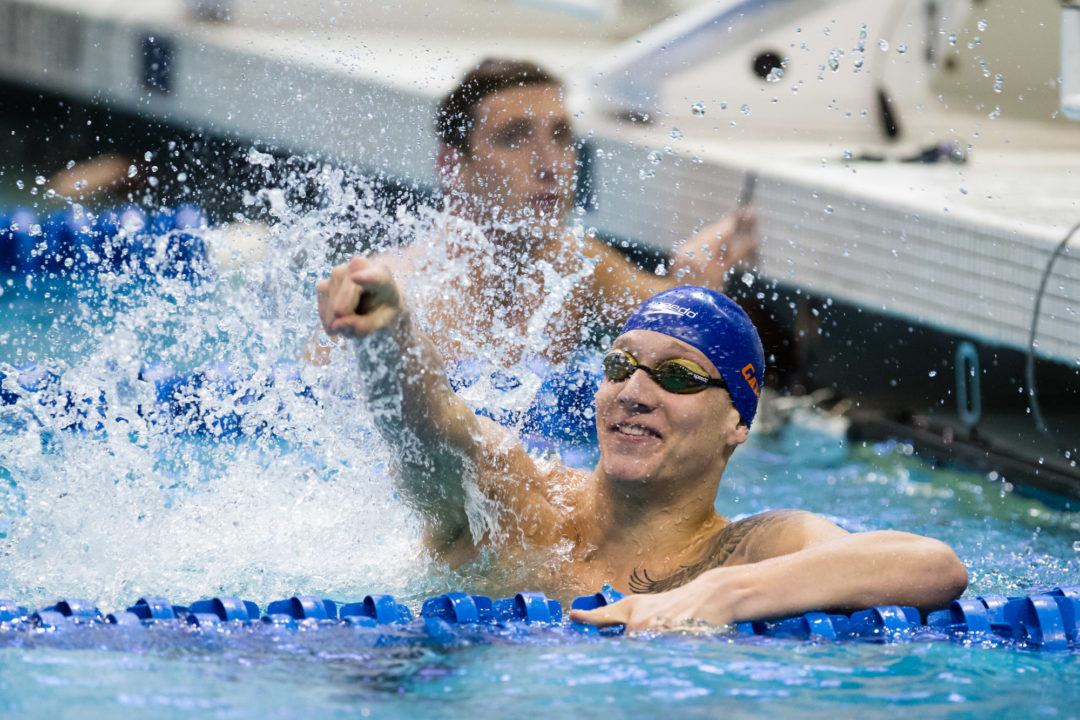With the NCAA season officially beginning next week with the nation’s first dual meet, now seems a fitting time to review the updated qualifying time standards for the 2018 NCAA Championships.
At the Division I level, the B standards have been frozen for the past several years, and 2018 is no exception. The B times remain the same, though A times have continued to get faster across the board. In terms of real-world impact, the B standards don’t have much significance. Swimming an A time in any event qualifies an athlete to compete in that event at NCAAs. Once into the meet, that athlete can enter any events with a B cut, up to three total events individually.
Merely making a B cut doesn’t earn an NCAA bid, though the fastest B cuts do make the invite list.
If the A times make your eyes pop, you’re not alone. As the NCAA has surged in speed, the qualifying times have become extraordinarily fast. A couple key events have crossed big barriers: the men’s 200 IM is now sub-1:42 for the first time in history. The men’s 400 IM dropped below 3:40. The women’s 200 back is now under 1:51, and women’s 100 breast under 59.
Here’s a brief refresher on how NCAA qualifying works (read the full explanation here):
- Individual Events: In individual races, all swimmers with “A” standards automatically qualify for the NCAA Championships. Thereafter, swimmers are chosen event-by-event, lined up to an equal number across all events, until the maximum number of individual swimmers have been selected (235 for men, 281 for women).
- Relay Events: All relays with the Qualifying Standard can swim at the NCAA Championships, provided they have 1 individual (swimmer or diver) invited to the meet as well. Once a team has a relay invited, they can swim any relay in which they have a provisional standard as well. Relays are qualified “to the team,” not to the individual swimmers, so teams can take whichever swimmers they want to participate in relays.
We’ve got the full standards below, or you can view them as a separate document here.
| Men | Women | |||
| A Standard | B Standard | Event | A Standard | B Standard |
| 19.05 | 20.19 | 50 free | 21.80 | 22.99 |
| 42.11 | 44.29 | 100 free | 47.53 | 49.99 |
| 1:32.54 | 1:37.99 | 200 free | 1:43.30 | 1:47.99 |
| 4:12.49 | 4:24.99 | 500 free | 4:36.30 | 4:47.79 |
| 14:40.75 | 15:30.39 | 1650 free | 15:53.50 | 16:30.59 |
| 45.49 | 48.29 | 100 fly | 51.19 | 54.49 |
| 1:41.44 | 1:47.99 | 200 fly | 1:53.80 | 1:59.59 |
| 45.25 | 48.49 | 100 back | 51.16 | 55.09 |
| 1:39.66 | 1:46.39 | 200 back | 1:50.99 | 1:59.19 |
| 51.74 | 55.39 | 100 breast | 58.85 | 1:02.49 |
| 1:52.94 | 1:59.79 | 200 breast | 2:07.18 | 2:15.99 |
| 1:41.88 | 1:49.09 | 200 IM | 1:55.00 | 2:01.59 |
| 3:39.95 | 3:54.49 | 400 IM | 4:04.70 | 4:19.39 |
| Qualifying | Provisional | Qualifying | Provisional | |
| 1:17.62 | 1:18.35 | 200 free relay | 1:28.71 | 1:29.57 |
| 2:52.10 | 2:53.23 | 400 free relay | 3:15.43 | 3:16.93 |
| 6:20.05 | 6:23.58 | 800 free relay | 7:03.86 | 7:07.86 |
| 1:24.82 | 1:25.62 | 200 medley relay | 1:36.89 | 1:37.51 |
| 3:07.46 | 3:08.95 | 400 medley relay | 3:32.67 | 3:34.48 |

What are the changes from last year and over the last 5, 10 years?
I would love to see this progression, over the last decade. Swimming has gotten so so fast lately
1:41.88 A standard for Men’s 200 IM, wow that’s fast!
I wonder if Ryan Murphy, Jack Conger, Will Licon, or Clark Smith will be able to defend their titles.
Lmao whats with the downvotes? Its obviously a joke.
Why are fewer men selected for NCAA? In the light of recent program cuts (particularly on the men’s side), would it make sense to have more swimmers/program compete in the championship meet?
The number of men are less than the number of women selected because there are fewer men participating than women. The caps for men and women are set to be relatively equal percentages of total participants. As such, a significant decrease in men’s participation overall compared to women could actually result in a decrease in the men’s cap number, not an increase.
So their penalized because less colleges have men’s team that makes sense how?
No one is being punished. The NCAA regulates all the size of all championships they sponsor based in some manner on the number of schools that sponsor the sport in question. Sports like Beach Volleyball, Water Polo, Men’s Volleyball all gave much smaller participation than basketball for example, so they have much smaller brackets. It has been a few years since I have gone through the data, but in the past swimmming has actually had a higher championship participant to total participant ratio than most sports. I’m not sure I follow reasoning that leads to the conclusion that a smaller sport ought to get more championship spots.
This is not much different from how the Olympics works. They have… Read more »
“IN THIS STORY:
Caeleb Dressel
Katie Ledecky
Simone Manuel”
i wondr if theyll make it
It’ll be close but I think they just might
lol